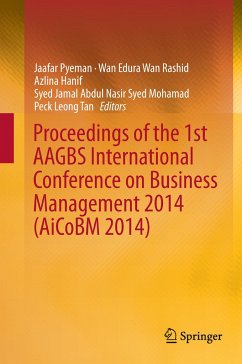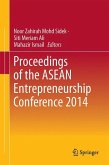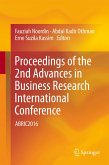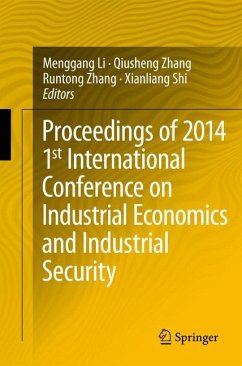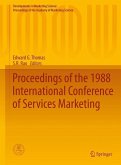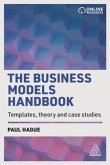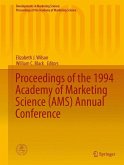Proceedings of the 1st AAGBS International Conference on Business Management 2014 (AiCoBM 2014)
Herausgegeben:Pyeman, Jaafar; Wan Rashid, Wan Edura; Hanif, Azlina; Syed Mohamad, Syed Jamal Abdul Nasir; Tan, Peck Leong
Proceedings of the 1st AAGBS International Conference on Business Management 2014 (AiCoBM 2014)
Herausgegeben:Pyeman, Jaafar; Wan Rashid, Wan Edura; Hanif, Azlina; Syed Mohamad, Syed Jamal Abdul Nasir; Tan, Peck Leong
- Gebundenes Buch
- Merkliste
- Auf die Merkliste
- Bewerten Bewerten
- Teilen
- Produkt teilen
- Produkterinnerung
- Produkterinnerung
The proceedings of the 1st AAGBS International Conference on Business Management 2014 (AiCoBM 2014), held in Penang, Malaysia, gathers 57 refereed papers. They cover areas relating to various aspects of business management and reflect the conference's three main themes (management and marketing, economics and finance, and entrepreneurship) and present original papers contributed by researchers, scholars, professionals and postgraduate students. They address a range of disciplines that encompass each of the main themes. Using basic and applied research findings together with case studies they…mehr
Andere Kunden interessierten sich auch für
![Proceedings of the ASEAN Entrepreneurship Conference 2014 Proceedings of the ASEAN Entrepreneurship Conference 2014]() Proceedings of the ASEAN Entrepreneurship Conference 2014121,99 €
Proceedings of the ASEAN Entrepreneurship Conference 2014121,99 €![Proceedings of the 2nd Advances in Business Research International Conference Proceedings of the 2nd Advances in Business Research International Conference]() Proceedings of the 2nd Advances in Business Research International Conference121,99 €
Proceedings of the 2nd Advances in Business Research International Conference121,99 €![Proceedings of 2014 1st International Conference on Industrial Economics and Industrial Security Proceedings of 2014 1st International Conference on Industrial Economics and Industrial Security]() Proceedings of 2014 1st International Conference on Industrial Economics and Industrial Security161,99 €
Proceedings of 2014 1st International Conference on Industrial Economics and Industrial Security161,99 €![Proceedings of the 1988 International Conference of Services Marketing Proceedings of the 1988 International Conference of Services Marketing]() Proceedings of the 1988 International Conference of Services Marketing122,99 €
Proceedings of the 1988 International Conference of Services Marketing122,99 €![Emotional Intelligence for Sales Leadership Emotional Intelligence for Sales Leadership]() Colleen StanleyEmotional Intelligence for Sales Leadership15,99 €
Colleen StanleyEmotional Intelligence for Sales Leadership15,99 €![The Business Models Handbook The Business Models Handbook]() Paul HagueThe Business Models Handbook32,99 €
Paul HagueThe Business Models Handbook32,99 €![Proceedings of the 1994 Academy of Marketing Science (AMS) Annual Conference Proceedings of the 1994 Academy of Marketing Science (AMS) Annual Conference]() Proceedings of the 1994 Academy of Marketing Science (AMS) Annual Conference82,99 €
Proceedings of the 1994 Academy of Marketing Science (AMS) Annual Conference82,99 €-
-
-
The proceedings of the 1st AAGBS International Conference on Business Management 2014 (AiCoBM 2014), held in Penang, Malaysia, gathers 57 refereed papers. They cover areas relating to various aspects of business management and reflect the conference's three main themes (management and marketing, economics and finance, and entrepreneurship) and present original papers contributed by researchers, scholars, professionals and postgraduate students. They address a range of disciplines that encompass each of the main themes. Using basic and applied research findings together with case studies they provide valuable information on current research trends in business management, international business, marketing, economics, finance, Islamic finance and economics, and entrepreneurship.
Produktdetails
- Produktdetails
- Verlag: Springer / Springer Nature Singapore / Springer, Berlin
- Artikelnr. des Verlages: 978-981-287-425-2
- 1st ed. 2016
- Seitenzahl: 668
- Erscheinungstermin: 11. August 2015
- Englisch
- Abmessung: 241mm x 160mm x 42mm
- Gewicht: 1100g
- ISBN-13: 9789812874252
- ISBN-10: 9812874259
- Artikelnr.: 42097742
- Herstellerkennzeichnung Die Herstellerinformationen sind derzeit nicht verfügbar.
- Verlag: Springer / Springer Nature Singapore / Springer, Berlin
- Artikelnr. des Verlages: 978-981-287-425-2
- 1st ed. 2016
- Seitenzahl: 668
- Erscheinungstermin: 11. August 2015
- Englisch
- Abmessung: 241mm x 160mm x 42mm
- Gewicht: 1100g
- ISBN-13: 9789812874252
- ISBN-10: 9812874259
- Artikelnr.: 42097742
- Herstellerkennzeichnung Die Herstellerinformationen sind derzeit nicht verfügbar.
Associate Professor Dr. Jaafar Pyeman is a Director of Arshad Ayub Graduate Business School (AAGBS), Universiti Teknologi MARA (UiTM), Malaysia. He obtained his MBA from University of Hull, United Kingdom and PhD from UiTM. He has broad experiences in leading the organizations as he was previously appointed as Deputy Dean of the Faculty of Business Management UiTM, Head of Professional & Offshore Program at AAGBS and Head of Postgraduate Studies at Malaysia Institute of Transport (MITRANS). He is a Fellow of Institute of Business Excellent (IBE) and MITRANS as well as a Secretary General of Malaysian Association of Learning and Development (MyLeaD). He is an active researcher, presented numerous research papers and he has published many papers in national and international journals. He has also involved as a reviewer for international conferences such as International Conference on Science and Social Research and 2nd Terengganu International Business and Economic Conference. Wan Edura is a Senior Lecturer of Faculty of Business Management, Universiti Teknologi MARA (UiTM), Shah Alam, Malaysia. She is also the Head for Center of Integrated Information and Publication, Institute of Business Excellence at UiTM, Shah Alam. Azlina Hanif is the Deputy Director (by Research) and a Senior Lecturer at Arshad Ayub Graduate Business School, Universiti Teknologi MARA, Shah Alam, Malaysia. Syed Jamal Abdul Nasir is an Associate Professor at Arshad Ayub Graduate Business School, Universiti Teknologi MARA, Shah Alam, Malaysia. Tan Peck Leong is a Senior Lecturer at Arshad Ayub Graduate Business School, Universiti Teknologi MARA, Shah Alam, Malaysia.
Acknowledgements.- Part I: Entrepreneurship.- Chapter 1: The Determinant of Technological Innovation Adoption in Malaysia SMEs.- Chapter 2: Market Orientation Conception on Commercialization of University Research Products with Moderating Effect of Organizational Culture.- Chapter 3: The Customers' Perception Towards Secrets Recipe's Reputation By Using The ReptrakTM Model.- Chapter 4: Examining the Applicability of Outside-In Open Innovation Approaches for Small B-to-B Businesses.- Chapter 5: Export Readiness Among Small and Medium-sized Enterprises in Malaysia.- Part II: Management and Marketing.- Chapter 6: Members of Parliament (MPs) and Internet Communication in Malaysia: An Empirical Study of Perceived Individual Factors and Continuance of Use.- Chapter 7: Linking Entry Timing (ET) and Entry Mode (EM) Decisions in International
Market Expansion by Malaysian Construction Firm: Towards the Development of ETEM Model.- Chapter 8: Factorial Structure of Spiritual Intelligence towards Purchasing Decision towards Halal Cosmetic Product.- Chapter 9: The Relationships Between Talent Management Practices, Employee Engagement and Employee Retention in the Information and Technology (IT) Organizations in Selangor.- Chapter 10: Impact of Organizational Image in Determining the Level of Engagement Among Commercial Banks' Employees.- Chapter 11: HRM Practices and Organizational Performance: A Conceptual Model on The Performance of Acquiring Companies.- Chapter 12: IPA Vs. SERVQUAL: Service Quality Measurement for Higher Education Industry.- Chapter 13: Exploring the Relationships among Transformational Leadership, Organizational Culture and Product Innovation using PLS-SEM.- Chapter 14: Managing and Improving the Duration in Computing the Vehicle Speed: A Case Study.- Chapter 15: The Effects of Brand Orientation, Brand Distinctiveness and Design Innovation on the Brand Performance of the Malaysian Furniture Manufacturing Firms.- Chapter 16: Supply Chain
Robustness and Resilience for Firm's Sustainability: Case Studies on Electronics Industry.- Chapter 17: Generation Y and Job Satisfaction-Work Styles, Professional Expectations and Career Concerns.- Chapter 18: Antecedents in Developing a Risk Culture in Public Listed Companies (PLCs): Introduction to Enterprise Risk Management (ERM).- Chapter 19: Factors Contributing to Paddy Farmers' Intention to Participate in Agriculture Takaful.- Chapter 20: Employee Prosocial Motivation and Interpersonal Citizenship Behavior: The Supervisor-Rating of Leader-Member Exchange Quality as a Mediator.- Chapter 21: Smartphone Product Appearance: What Drive Consumers' Purchase
Decision?.- Chapter 22: A Conceptual Framework on Determinants of Enterprise Risk Management (ERM) Adoption: A study in Manufacturing Small and Medium Enterprises (SMEs).- Chapter 23: Criteria Selection for Halal Casual Dining Restaurant.- Chapter 24: Impact of Mindful Consumption (MC) on Investment Decision: a Study Within Malaysian Individual Investors.- Chapter 25: PADI Model: The Role of Malaysian's Emotional Experience on National Car.- Chapter 26: Corporate Image and Brand Identification of Islamic Banks: the Perspective of Customers'.- Chapter 27: Career Commitment and Intention to Leave Among ICT Professionals in Malaysia.- Chapter 28: Enhancing Business Performance Through Supply Chain Integration Strategy of Food Processing Industry in Malaysia: A Conceptual Paper.- Chapter 29: Work and Home Demands on Work-Family Conflict among Academicians in Achieving Work-Life Balance: A Conceptual Study.- Chapter 30: Evaluating Loyalty Intention through the Influence of Servicescapes
and Shoppers' Experiential Values.- Chapter 31: The Relationship Between Human Resource Diversity Management Practices
and Organizational Citizenship Behavior.- Chapter 32: Shareholder Activism in Malaysia: Exploring a Missing Parameter.- Chapter 33: Linking Superior Influence, Peer Influence, and Locus ofControl to
Ethical Behavior: A Conceptual Model.- Chapter 34: Measuring Walkability Attributes of Pedestrians Rail Commuter: A Pilot Study.- Chapter 35: Experiential Marketing Influence on Customers Lifetime Value of the Hotel Industry.- Chapter 36: The Effects of Indirect Experience of Hotel Customers on Brand Association and Loyalty in Iran.- Chapter 37: Information Technology and Competitive Advantages Among Small and Medium Enterprises in Malaysian Tourism Industry.- Chapter 38: Social Support, Academic Self-Concept, Education Goals, Academic Aspiration, and Decision to Study Among Residential Students of a Malaysian Public University.- Part III: Economics and Finance.- Chapter 39: Factors Affecting External Debt in Malaysia: An Empirical Investigation.- Chapter 40: Relationship Between Foreign Direct Investment and Financial Development Empirical Evidence From ASEAN-5.- Chapter 41: Short-run Performance of Malaysian Acquiring Firms in Cross Border Mergers and Acquisitions.- Chapter 42: Preliminary Investigation on the Determinants of Household Debt Burden.- Chapter 43: An Examination of FDI in China, Singapore and Malaysia.- Chapter 44: Developing Primary Market Spread and Measuring Financial Performance of Staff Housing Government Loans.- Chapter 45: Financial Behavior of Credit Card Holders on the Implementation of Tiered Interest Rate.- Chapter 46: Non Linearity between Ownership Concentration and Firm Value.- Chapter 47: Standardization of Islamic insurance Models within the Shariah Parameter in Selected Countries.- Chapter 48: Bank Fragility and Its Determinants: Evidence From Malaysian Commercial Banks.- Chapter 49: Indirect Financial Distress Costs: Evidence From Trading and Service Sector.- Chapter 50: Determinants of Indirect Financial Distress Costs.- Chapter 51: Assessing of Malaysian Firms Cross Border Mergers and Acquisitions Efficiency.- Chapter 52: Nonlinear Relationship Between Debt and Firm Value in Malaysian Firms.- Chapter 53: Factorial Validation of Salient Beliefs Pertaining To Islamic Financing Instrument.- Chapter 54: Gold Investment Account in Malaysia Comparative Review of Gold Investment Scheme between Maybank Bhd and Genneva Malaysia Sdn. Bhd..- Chapter 55: Who Consumes Fresh Fruits in Malaysia? Analysis on Socio-Demographic Influence.- Chapter 56: Impact of Demographic Factors and Work Environment on Fertility Rates in Malaysia.- Chapter 57: Transformational Leaders and Organizational Performance.
Market Expansion by Malaysian Construction Firm: Towards the Development of ETEM Model.- Chapter 8: Factorial Structure of Spiritual Intelligence towards Purchasing Decision towards Halal Cosmetic Product.- Chapter 9: The Relationships Between Talent Management Practices, Employee Engagement and Employee Retention in the Information and Technology (IT) Organizations in Selangor.- Chapter 10: Impact of Organizational Image in Determining the Level of Engagement Among Commercial Banks' Employees.- Chapter 11: HRM Practices and Organizational Performance: A Conceptual Model on The Performance of Acquiring Companies.- Chapter 12: IPA Vs. SERVQUAL: Service Quality Measurement for Higher Education Industry.- Chapter 13: Exploring the Relationships among Transformational Leadership, Organizational Culture and Product Innovation using PLS-SEM.- Chapter 14: Managing and Improving the Duration in Computing the Vehicle Speed: A Case Study.- Chapter 15: The Effects of Brand Orientation, Brand Distinctiveness and Design Innovation on the Brand Performance of the Malaysian Furniture Manufacturing Firms.- Chapter 16: Supply Chain
Robustness and Resilience for Firm's Sustainability: Case Studies on Electronics Industry.- Chapter 17: Generation Y and Job Satisfaction-Work Styles, Professional Expectations and Career Concerns.- Chapter 18: Antecedents in Developing a Risk Culture in Public Listed Companies (PLCs): Introduction to Enterprise Risk Management (ERM).- Chapter 19: Factors Contributing to Paddy Farmers' Intention to Participate in Agriculture Takaful.- Chapter 20: Employee Prosocial Motivation and Interpersonal Citizenship Behavior: The Supervisor-Rating of Leader-Member Exchange Quality as a Mediator.- Chapter 21: Smartphone Product Appearance: What Drive Consumers' Purchase
Decision?.- Chapter 22: A Conceptual Framework on Determinants of Enterprise Risk Management (ERM) Adoption: A study in Manufacturing Small and Medium Enterprises (SMEs).- Chapter 23: Criteria Selection for Halal Casual Dining Restaurant.- Chapter 24: Impact of Mindful Consumption (MC) on Investment Decision: a Study Within Malaysian Individual Investors.- Chapter 25: PADI Model: The Role of Malaysian's Emotional Experience on National Car.- Chapter 26: Corporate Image and Brand Identification of Islamic Banks: the Perspective of Customers'.- Chapter 27: Career Commitment and Intention to Leave Among ICT Professionals in Malaysia.- Chapter 28: Enhancing Business Performance Through Supply Chain Integration Strategy of Food Processing Industry in Malaysia: A Conceptual Paper.- Chapter 29: Work and Home Demands on Work-Family Conflict among Academicians in Achieving Work-Life Balance: A Conceptual Study.- Chapter 30: Evaluating Loyalty Intention through the Influence of Servicescapes
and Shoppers' Experiential Values.- Chapter 31: The Relationship Between Human Resource Diversity Management Practices
and Organizational Citizenship Behavior.- Chapter 32: Shareholder Activism in Malaysia: Exploring a Missing Parameter.- Chapter 33: Linking Superior Influence, Peer Influence, and Locus ofControl to
Ethical Behavior: A Conceptual Model.- Chapter 34: Measuring Walkability Attributes of Pedestrians Rail Commuter: A Pilot Study.- Chapter 35: Experiential Marketing Influence on Customers Lifetime Value of the Hotel Industry.- Chapter 36: The Effects of Indirect Experience of Hotel Customers on Brand Association and Loyalty in Iran.- Chapter 37: Information Technology and Competitive Advantages Among Small and Medium Enterprises in Malaysian Tourism Industry.- Chapter 38: Social Support, Academic Self-Concept, Education Goals, Academic Aspiration, and Decision to Study Among Residential Students of a Malaysian Public University.- Part III: Economics and Finance.- Chapter 39: Factors Affecting External Debt in Malaysia: An Empirical Investigation.- Chapter 40: Relationship Between Foreign Direct Investment and Financial Development Empirical Evidence From ASEAN-5.- Chapter 41: Short-run Performance of Malaysian Acquiring Firms in Cross Border Mergers and Acquisitions.- Chapter 42: Preliminary Investigation on the Determinants of Household Debt Burden.- Chapter 43: An Examination of FDI in China, Singapore and Malaysia.- Chapter 44: Developing Primary Market Spread and Measuring Financial Performance of Staff Housing Government Loans.- Chapter 45: Financial Behavior of Credit Card Holders on the Implementation of Tiered Interest Rate.- Chapter 46: Non Linearity between Ownership Concentration and Firm Value.- Chapter 47: Standardization of Islamic insurance Models within the Shariah Parameter in Selected Countries.- Chapter 48: Bank Fragility and Its Determinants: Evidence From Malaysian Commercial Banks.- Chapter 49: Indirect Financial Distress Costs: Evidence From Trading and Service Sector.- Chapter 50: Determinants of Indirect Financial Distress Costs.- Chapter 51: Assessing of Malaysian Firms Cross Border Mergers and Acquisitions Efficiency.- Chapter 52: Nonlinear Relationship Between Debt and Firm Value in Malaysian Firms.- Chapter 53: Factorial Validation of Salient Beliefs Pertaining To Islamic Financing Instrument.- Chapter 54: Gold Investment Account in Malaysia Comparative Review of Gold Investment Scheme between Maybank Bhd and Genneva Malaysia Sdn. Bhd..- Chapter 55: Who Consumes Fresh Fruits in Malaysia? Analysis on Socio-Demographic Influence.- Chapter 56: Impact of Demographic Factors and Work Environment on Fertility Rates in Malaysia.- Chapter 57: Transformational Leaders and Organizational Performance.
Acknowledgements.- Part I: Entrepreneurship.- Chapter 1: The Determinant of Technological Innovation Adoption in Malaysia SMEs.- Chapter 2: Market Orientation Conception on Commercialization of University Research Products with Moderating Effect of Organizational Culture.- Chapter 3: The Customers' Perception Towards Secrets Recipe's Reputation By Using The ReptrakTM Model.- Chapter 4: Examining the Applicability of Outside-In Open Innovation Approaches for Small B-to-B Businesses.- Chapter 5: Export Readiness Among Small and Medium-sized Enterprises in Malaysia.- Part II: Management and Marketing.- Chapter 6: Members of Parliament (MPs) and Internet Communication in Malaysia: An Empirical Study of Perceived Individual Factors and Continuance of Use.- Chapter 7: Linking Entry Timing (ET) and Entry Mode (EM) Decisions in International
Market Expansion by Malaysian Construction Firm: Towards the Development of ETEM Model.- Chapter 8: Factorial Structure of Spiritual Intelligence towards Purchasing Decision towards Halal Cosmetic Product.- Chapter 9: The Relationships Between Talent Management Practices, Employee Engagement and Employee Retention in the Information and Technology (IT) Organizations in Selangor.- Chapter 10: Impact of Organizational Image in Determining the Level of Engagement Among Commercial Banks' Employees.- Chapter 11: HRM Practices and Organizational Performance: A Conceptual Model on The Performance of Acquiring Companies.- Chapter 12: IPA Vs. SERVQUAL: Service Quality Measurement for Higher Education Industry.- Chapter 13: Exploring the Relationships among Transformational Leadership, Organizational Culture and Product Innovation using PLS-SEM.- Chapter 14: Managing and Improving the Duration in Computing the Vehicle Speed: A Case Study.- Chapter 15: The Effects of Brand Orientation, Brand Distinctiveness and Design Innovation on the Brand Performance of the Malaysian Furniture Manufacturing Firms.- Chapter 16: Supply Chain
Robustness and Resilience for Firm's Sustainability: Case Studies on Electronics Industry.- Chapter 17: Generation Y and Job Satisfaction-Work Styles, Professional Expectations and Career Concerns.- Chapter 18: Antecedents in Developing a Risk Culture in Public Listed Companies (PLCs): Introduction to Enterprise Risk Management (ERM).- Chapter 19: Factors Contributing to Paddy Farmers' Intention to Participate in Agriculture Takaful.- Chapter 20: Employee Prosocial Motivation and Interpersonal Citizenship Behavior: The Supervisor-Rating of Leader-Member Exchange Quality as a Mediator.- Chapter 21: Smartphone Product Appearance: What Drive Consumers' Purchase
Decision?.- Chapter 22: A Conceptual Framework on Determinants of Enterprise Risk Management (ERM) Adoption: A study in Manufacturing Small and Medium Enterprises (SMEs).- Chapter 23: Criteria Selection for Halal Casual Dining Restaurant.- Chapter 24: Impact of Mindful Consumption (MC) on Investment Decision: a Study Within Malaysian Individual Investors.- Chapter 25: PADI Model: The Role of Malaysian's Emotional Experience on National Car.- Chapter 26: Corporate Image and Brand Identification of Islamic Banks: the Perspective of Customers'.- Chapter 27: Career Commitment and Intention to Leave Among ICT Professionals in Malaysia.- Chapter 28: Enhancing Business Performance Through Supply Chain Integration Strategy of Food Processing Industry in Malaysia: A Conceptual Paper.- Chapter 29: Work and Home Demands on Work-Family Conflict among Academicians in Achieving Work-Life Balance: A Conceptual Study.- Chapter 30: Evaluating Loyalty Intention through the Influence of Servicescapes
and Shoppers' Experiential Values.- Chapter 31: The Relationship Between Human Resource Diversity Management Practices
and Organizational Citizenship Behavior.- Chapter 32: Shareholder Activism in Malaysia: Exploring a Missing Parameter.- Chapter 33: Linking Superior Influence, Peer Influence, and Locus ofControl to
Ethical Behavior: A Conceptual Model.- Chapter 34: Measuring Walkability Attributes of Pedestrians Rail Commuter: A Pilot Study.- Chapter 35: Experiential Marketing Influence on Customers Lifetime Value of the Hotel Industry.- Chapter 36: The Effects of Indirect Experience of Hotel Customers on Brand Association and Loyalty in Iran.- Chapter 37: Information Technology and Competitive Advantages Among Small and Medium Enterprises in Malaysian Tourism Industry.- Chapter 38: Social Support, Academic Self-Concept, Education Goals, Academic Aspiration, and Decision to Study Among Residential Students of a Malaysian Public University.- Part III: Economics and Finance.- Chapter 39: Factors Affecting External Debt in Malaysia: An Empirical Investigation.- Chapter 40: Relationship Between Foreign Direct Investment and Financial Development Empirical Evidence From ASEAN-5.- Chapter 41: Short-run Performance of Malaysian Acquiring Firms in Cross Border Mergers and Acquisitions.- Chapter 42: Preliminary Investigation on the Determinants of Household Debt Burden.- Chapter 43: An Examination of FDI in China, Singapore and Malaysia.- Chapter 44: Developing Primary Market Spread and Measuring Financial Performance of Staff Housing Government Loans.- Chapter 45: Financial Behavior of Credit Card Holders on the Implementation of Tiered Interest Rate.- Chapter 46: Non Linearity between Ownership Concentration and Firm Value.- Chapter 47: Standardization of Islamic insurance Models within the Shariah Parameter in Selected Countries.- Chapter 48: Bank Fragility and Its Determinants: Evidence From Malaysian Commercial Banks.- Chapter 49: Indirect Financial Distress Costs: Evidence From Trading and Service Sector.- Chapter 50: Determinants of Indirect Financial Distress Costs.- Chapter 51: Assessing of Malaysian Firms Cross Border Mergers and Acquisitions Efficiency.- Chapter 52: Nonlinear Relationship Between Debt and Firm Value in Malaysian Firms.- Chapter 53: Factorial Validation of Salient Beliefs Pertaining To Islamic Financing Instrument.- Chapter 54: Gold Investment Account in Malaysia Comparative Review of Gold Investment Scheme between Maybank Bhd and Genneva Malaysia Sdn. Bhd..- Chapter 55: Who Consumes Fresh Fruits in Malaysia? Analysis on Socio-Demographic Influence.- Chapter 56: Impact of Demographic Factors and Work Environment on Fertility Rates in Malaysia.- Chapter 57: Transformational Leaders and Organizational Performance.
Market Expansion by Malaysian Construction Firm: Towards the Development of ETEM Model.- Chapter 8: Factorial Structure of Spiritual Intelligence towards Purchasing Decision towards Halal Cosmetic Product.- Chapter 9: The Relationships Between Talent Management Practices, Employee Engagement and Employee Retention in the Information and Technology (IT) Organizations in Selangor.- Chapter 10: Impact of Organizational Image in Determining the Level of Engagement Among Commercial Banks' Employees.- Chapter 11: HRM Practices and Organizational Performance: A Conceptual Model on The Performance of Acquiring Companies.- Chapter 12: IPA Vs. SERVQUAL: Service Quality Measurement for Higher Education Industry.- Chapter 13: Exploring the Relationships among Transformational Leadership, Organizational Culture and Product Innovation using PLS-SEM.- Chapter 14: Managing and Improving the Duration in Computing the Vehicle Speed: A Case Study.- Chapter 15: The Effects of Brand Orientation, Brand Distinctiveness and Design Innovation on the Brand Performance of the Malaysian Furniture Manufacturing Firms.- Chapter 16: Supply Chain
Robustness and Resilience for Firm's Sustainability: Case Studies on Electronics Industry.- Chapter 17: Generation Y and Job Satisfaction-Work Styles, Professional Expectations and Career Concerns.- Chapter 18: Antecedents in Developing a Risk Culture in Public Listed Companies (PLCs): Introduction to Enterprise Risk Management (ERM).- Chapter 19: Factors Contributing to Paddy Farmers' Intention to Participate in Agriculture Takaful.- Chapter 20: Employee Prosocial Motivation and Interpersonal Citizenship Behavior: The Supervisor-Rating of Leader-Member Exchange Quality as a Mediator.- Chapter 21: Smartphone Product Appearance: What Drive Consumers' Purchase
Decision?.- Chapter 22: A Conceptual Framework on Determinants of Enterprise Risk Management (ERM) Adoption: A study in Manufacturing Small and Medium Enterprises (SMEs).- Chapter 23: Criteria Selection for Halal Casual Dining Restaurant.- Chapter 24: Impact of Mindful Consumption (MC) on Investment Decision: a Study Within Malaysian Individual Investors.- Chapter 25: PADI Model: The Role of Malaysian's Emotional Experience on National Car.- Chapter 26: Corporate Image and Brand Identification of Islamic Banks: the Perspective of Customers'.- Chapter 27: Career Commitment and Intention to Leave Among ICT Professionals in Malaysia.- Chapter 28: Enhancing Business Performance Through Supply Chain Integration Strategy of Food Processing Industry in Malaysia: A Conceptual Paper.- Chapter 29: Work and Home Demands on Work-Family Conflict among Academicians in Achieving Work-Life Balance: A Conceptual Study.- Chapter 30: Evaluating Loyalty Intention through the Influence of Servicescapes
and Shoppers' Experiential Values.- Chapter 31: The Relationship Between Human Resource Diversity Management Practices
and Organizational Citizenship Behavior.- Chapter 32: Shareholder Activism in Malaysia: Exploring a Missing Parameter.- Chapter 33: Linking Superior Influence, Peer Influence, and Locus ofControl to
Ethical Behavior: A Conceptual Model.- Chapter 34: Measuring Walkability Attributes of Pedestrians Rail Commuter: A Pilot Study.- Chapter 35: Experiential Marketing Influence on Customers Lifetime Value of the Hotel Industry.- Chapter 36: The Effects of Indirect Experience of Hotel Customers on Brand Association and Loyalty in Iran.- Chapter 37: Information Technology and Competitive Advantages Among Small and Medium Enterprises in Malaysian Tourism Industry.- Chapter 38: Social Support, Academic Self-Concept, Education Goals, Academic Aspiration, and Decision to Study Among Residential Students of a Malaysian Public University.- Part III: Economics and Finance.- Chapter 39: Factors Affecting External Debt in Malaysia: An Empirical Investigation.- Chapter 40: Relationship Between Foreign Direct Investment and Financial Development Empirical Evidence From ASEAN-5.- Chapter 41: Short-run Performance of Malaysian Acquiring Firms in Cross Border Mergers and Acquisitions.- Chapter 42: Preliminary Investigation on the Determinants of Household Debt Burden.- Chapter 43: An Examination of FDI in China, Singapore and Malaysia.- Chapter 44: Developing Primary Market Spread and Measuring Financial Performance of Staff Housing Government Loans.- Chapter 45: Financial Behavior of Credit Card Holders on the Implementation of Tiered Interest Rate.- Chapter 46: Non Linearity between Ownership Concentration and Firm Value.- Chapter 47: Standardization of Islamic insurance Models within the Shariah Parameter in Selected Countries.- Chapter 48: Bank Fragility and Its Determinants: Evidence From Malaysian Commercial Banks.- Chapter 49: Indirect Financial Distress Costs: Evidence From Trading and Service Sector.- Chapter 50: Determinants of Indirect Financial Distress Costs.- Chapter 51: Assessing of Malaysian Firms Cross Border Mergers and Acquisitions Efficiency.- Chapter 52: Nonlinear Relationship Between Debt and Firm Value in Malaysian Firms.- Chapter 53: Factorial Validation of Salient Beliefs Pertaining To Islamic Financing Instrument.- Chapter 54: Gold Investment Account in Malaysia Comparative Review of Gold Investment Scheme between Maybank Bhd and Genneva Malaysia Sdn. Bhd..- Chapter 55: Who Consumes Fresh Fruits in Malaysia? Analysis on Socio-Demographic Influence.- Chapter 56: Impact of Demographic Factors and Work Environment on Fertility Rates in Malaysia.- Chapter 57: Transformational Leaders and Organizational Performance.

